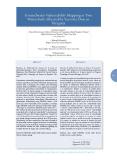Groundwater vulnerability mapping in two watersheds affected by Yacyreta Dam in Paraguay

View/
Date
2015Author
Musálem Castillejos, Karim
McDonald, Morag
Jiménez Otárola, Francisco
Laino Guanes, Rafaela María
Type
Artículo
Metadata
Show full item recordAbstract
Groundwater vulnerability mapping was conducted for two
intensive agriculture and urban watersheds draining to the
Yacyreta Dam in Paraguay. Two widely used overlaying
methods (GOD and DRASTIC) were applied and compared
to determine groundwater vulnerability to contamination.
Possible effects of climate change on vulnerability values
were also assessed using climate change scenarios provided
by third authors. Finally, the possible effects of water table
variations derived from Yacyreta Dam operations was
projected on groundwater vulnerability. Determination of
groundwater vulnerability using DRASTIC shows a 56%
of the area of the watersheds to be classified as “medium
high” (DRASTIC index 140 – 159) and a 22% as either “high”,
“very high” or “maximum” (DRASTIC index values 160 – >
200). GOD on the other hand showed a 96% of the area of the
watersheds with a “moderate vulnerability” to contaminants
(values 0.3-0.5) and a 4% of “high vulnerability” (values 0.51
– 0.6). Vulnerability classes remained the same regardless of
any climate change scenarios reviewed, for a 100 year span.
Operation by the dam, specifically a five meter elevation of
the water table scenario, suggests an increase in vulnerability
in lower parts of the watersheds. Finally we compare GOD
and DRASTIC models and their suitability regarding the
available data for the region and scenario building.
Keywords
Is part of
Tecnología y Ciencias del Agua. Volumen 6, número 6 (noviembre - diciembre 2015), páginas 49-61
URI (Permanet link to cite or share this item)
https://repositorio.catie.ac.cr/handle/11554/8314Collections
- Publicaciones y documentos [4419]

